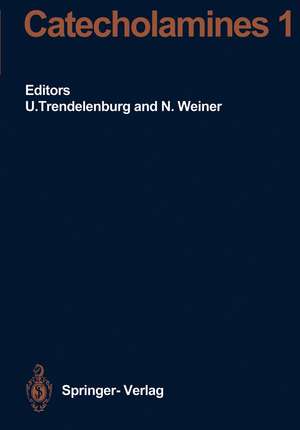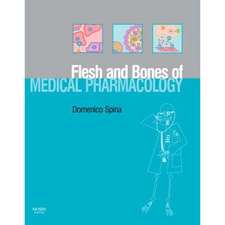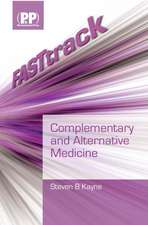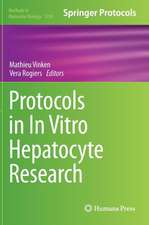Catecholamines I: Handbook of Experimental Pharmacology, cartea 90 / 1
Contribuţii de H. Bönisch, J.P.M. Finberg, W.W. Fleming, K.-H. Graefe, S.Z. Langer, J. Lehmann, H. Matthaei, P.B. Molinoff, A. Philippu, K.F. Tipton, U. Trendelenburg, D.P. Westfall, H. Winkler, B.B. Wolfe, M.B.H. Youdimen Limba Engleză Paperback – 8 mar 2012
Din seria Handbook of Experimental Pharmacology
- 5%
 Preț: 3517.78 lei
Preț: 3517.78 lei - 5%
 Preț: 1425.97 lei
Preț: 1425.97 lei - 5%
 Preț: 1435.28 lei
Preț: 1435.28 lei - 5%
 Preț: 1430.52 lei
Preț: 1430.52 lei - 5%
 Preț: 1930.69 lei
Preț: 1930.69 lei - 5%
 Preț: 1922.47 lei
Preț: 1922.47 lei - 5%
 Preț: 1937.46 lei
Preț: 1937.46 lei - 5%
 Preț: 2117.58 lei
Preț: 2117.58 lei - 5%
 Preț: 2119.96 lei
Preț: 2119.96 lei - 5%
 Preț: 2117.38 lei
Preț: 2117.38 lei - 5%
 Preț: 1088.17 lei
Preț: 1088.17 lei - 5%
 Preț: 1098.27 lei
Preț: 1098.27 lei - 5%
 Preț: 1420.29 lei
Preț: 1420.29 lei - 5%
 Preț: 1104.84 lei
Preț: 1104.84 lei - 5%
 Preț: 1104.84 lei
Preț: 1104.84 lei - 5%
 Preț: 1108.14 lei
Preț: 1108.14 lei - 5%
 Preț: 1106.69 lei
Preț: 1106.69 lei - 5%
 Preț: 1105.77 lei
Preț: 1105.77 lei - 5%
 Preț: 1174.35 lei
Preț: 1174.35 lei - 5%
 Preț: 1432.50 lei
Preț: 1432.50 lei - 5%
 Preț: 408.48 lei
Preț: 408.48 lei - 5%
 Preț: 409.63 lei
Preț: 409.63 lei - 5%
 Preț: 539.90 lei
Preț: 539.90 lei - 5%
 Preț: 720.47 lei
Preț: 720.47 lei - 5%
 Preț: 733.09 lei
Preț: 733.09 lei - 5%
 Preț: 731.27 lei
Preț: 731.27 lei - 5%
 Preț: 746.43 lei
Preț: 746.43 lei - 5%
 Preț: 747.72 lei
Preț: 747.72 lei - 5%
 Preț: 725.24 lei
Preț: 725.24 lei - 5%
 Preț: 742.80 lei
Preț: 742.80 lei - 5%
 Preț: 393.23 lei
Preț: 393.23 lei - 5%
 Preț: 735.66 lei
Preț: 735.66 lei - 5%
 Preț: 728.33 lei
Preț: 728.33 lei - 5%
 Preț: 389.52 lei
Preț: 389.52 lei - 5%
 Preț: 730.71 lei
Preț: 730.71 lei - 5%
 Preț: 740.58 lei
Preț: 740.58 lei - 5%
 Preț: 730.19 lei
Preț: 730.19 lei - 5%
 Preț: 723.42 lei
Preț: 723.42 lei - 5%
 Preț: 731.27 lei
Preț: 731.27 lei - 5%
 Preț: 726.68 lei
Preț: 726.68 lei - 5%
 Preț: 3516.49 lei
Preț: 3516.49 lei - 5%
 Preț: 729.26 lei
Preț: 729.26 lei - 5%
 Preț: 737.11 lei
Preț: 737.11 lei - 5%
 Preț: 730.92 lei
Preț: 730.92 lei - 5%
 Preț: 738.78 lei
Preț: 738.78 lei - 5%
 Preț: 909.94 lei
Preț: 909.94 lei - 5%
 Preț: 720.10 lei
Preț: 720.10 lei - 5%
 Preț: 734.74 lei
Preț: 734.74 lei - 5%
 Preț: 727.80 lei
Preț: 727.80 lei
Preț: 736.55 lei
Preț vechi: 775.32 lei
-5% Nou
Puncte Express: 1105
Preț estimativ în valută:
140.96€ • 146.62$ • 116.37£
140.96€ • 146.62$ • 116.37£
Carte tipărită la comandă
Livrare economică 14-28 aprilie
Preluare comenzi: 021 569.72.76
Specificații
ISBN-13: 9783642466274
ISBN-10: 3642466273
Pagini: 596
Ilustrații: XX, 571 p.
Dimensiuni: 170 x 244 x 31 mm
Greutate: 0.93 kg
Ediția:Softcover reprint of the original 1st ed. 1988
Editura: Springer Berlin, Heidelberg
Colecția Springer
Seria Handbook of Experimental Pharmacology
Locul publicării:Berlin, Heidelberg, Germany
ISBN-10: 3642466273
Pagini: 596
Ilustrații: XX, 571 p.
Dimensiuni: 170 x 244 x 31 mm
Greutate: 0.93 kg
Ediția:Softcover reprint of the original 1st ed. 1988
Editura: Springer Berlin, Heidelberg
Colecția Springer
Seria Handbook of Experimental Pharmacology
Locul publicării:Berlin, Heidelberg, Germany
Public țintă
ResearchCuprins
1 Transport and Storage of Catecholamines in Vesicles.- A. Introduction.- B. Biogenesis.- C. Uptake.- D. Stroage.- E. References.- 2 Occurrence and Mechanism of Exocytosis in Adrenal Medulla and Sympathetic Nerve.- A. Introduction.- B. Evidence for Exocytosis.- C. Mechanism of Exocytosis.- D. References.- 3 Monamine Oxidase.- A. Introduction.- B. Classification.- C. Distribution and Localization.- D. Properties of the Enzyme.- E. Kinetics of the Reaction.- F. Reaction Mechanism.- G. Specificity.- H. The Influence of Membrane Environment.- J. Multiple Forms.- K. Multiple Forms as an In Vivo Reality and Their Function.- L. Inhibitors.- M. Physiological Role and Functional Activity of MAO; Biochemical and Behavioural Correlates.- N. Psychiatric and Neurological Disorders: MAO Activity and MAO Inhibitors as Drugs.- O. Future Perspectives.- P. Addendum.- Q. References.- 4 The Transport of Amines Across the Axonal Membranes of Noradrenergic and Dopaminergic Neurones.- A. Introduction.- B. Neuronal Uptake.- C. Neuronal Amine Metabolism.- D. Neuronal Efflux.- E. Proposed Mechanism of Neuronal Uptake: A Summing up.- F. References.- 5 The Mechanism of Action of Indirectly Acting Sympathomimetic Amines.- A. Introduction.- B. The Adrenergic Nerve Ending.- C. The Experimental Models.- D. Carrier-Mediated Uptake of (+)-Amphetamine.- E. The Release of 3H-Noradrenaline After Inhibition of MAO and of Vesicular Uptake.- F. Factors Involved in the Release of Axoplasmic 3H-Noradrenaline.- H. The Co-transport of Sodium.- G. The Release of 3H-Noradrenaline from Adrenergic Nerve Endings with Intact Storage Vesicles and Intact MAO (COMT Inhibited).- H. The Effects of Indirectly Acting Amines in the Presence of a Reserpine-like Compound.- J. Factors Which Influence the 3H-Noradrenaline-Releasing Effect of Indirectly Acting Amines.- K. The Release by Indirectly Acting Amines of Dopamine from Dopaminergic Nerve Endings.- L. Conclusions.- M. References.- 6 The Extraneuronal Uptake and Metabolism of Catecholamines.- A. Introduction.- B. Uptake2.- C. The Extraneuronal Metabolizing Systems.- D. Supersensitivity to Catecholamines After Inhibition of the Extraneuronal O-Methylating System.- E. The Interaction Between the Neuronal and the Extraneuronal Sites of Loss.- F. Conclusions: A Comparison of Uptake2 with Uptake1.- G. References.- 7 Catecholamines Receptors.- A. Introduction.- B. Relationship of Catecholamine Receptors to Effector Systems.- C. In Vitro Binding Assays.- D. In Vitro Properties of Adrenoceptors.- E. Localization of Catecholamine Receptors.- F. Multiplicity of Catecholamine Receptor Subtypes.- G. Regulation of the Sensitivity of Catecholamine Receptor Systems.- H. Agonist-Induced Desensitization.- J. Ontogeny of Catecholamine Receptors in the Central Nervous System.- K. Solubilization, Purification, and Reconstitution of Catecholamine Receptor/Effector Systems.- L. Molecular Cloning of Catecholamine Receptors.- M. Conclusion.- N. References.- 8 Presynaptic Receptors on Catecholamine Neurones.- A. Introduction and Definition of Terms.- B. The Dopamine Autoreceptor.- C. Presynaptic Heteroreceptors Modulating Dopamine Function..- D. Autoadrenoceptors.- E. Presynaptic Dopamine Receptors Modulating Noradrenaline Release.- F. Conclusions.- G. References.- 9 Adaptive Supersensitivity.- A. Introduction.- B. The Induction of Adaptive Supersensitivity.- C. Characteristics of Adaptive Supersensitivity.- D. Possible Mechanisms for Changes in Sensitivity of Effector Cells and Evidence Supporting or Opposing these Mechanisms.- E. Summary and Conclusions.- F. References.











